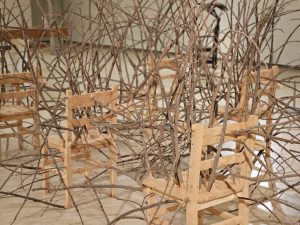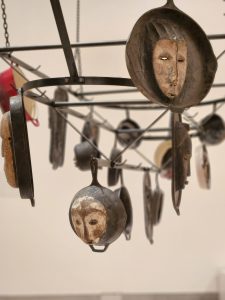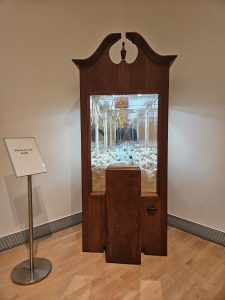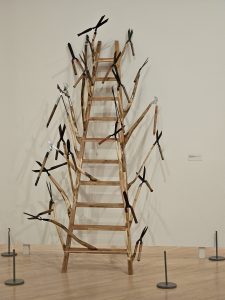I am good—pretty good—at keeping my hands in my pockets or clasped behind my back while in an art museum. Rules keep the art safe. Even so, between my poor eyesight and exuberance in the presence of objects of wonder, I have driven a number of guards on two continents to distraction. I could barely control myself here.
The Rose Art Museum
Quiet filled the white space of the Rose Art Museum. A dank, damp Thursday was obviously the right time to come. I circled around the exhibition of Pop Art on the main floor, a sweet show, and there was a joyous and slightly weird Jim Dine, Double Red Bathroom (1962) that absolutely rang my chimes. [The internet is a wonderful source of images, but this work looks drained an inert. Be warned.]
I descended to the lower level and the first gallery of Hugh Hayden: Home Work. Goosebumps. Immediately.
Briar Patches
A staff member pointed out to me that the six desks in Briar Patch (2018) weren’t ordinary wooden school desks as they looked at first glance. Rather than found objects latticed with branches, they were forms Hayden had carved individually. Before I even thought about the title or the content of the array, I could hear my grandfather’s voice animating Brer Rabbit in the Uncle Remus stories by Joel Chandler Harris. The intersection of folklore, racism, and caste can’t be addressed here. The briar patch that is so potentially dangerous, however, is also the means through which Brer Rabbit engineers his escape from Brer Fox and the mucilaginous Tar Baby.
The finely crafted desks sprouting thorny branches are the source of education that can offer both power and self-determination. These seats, however, simultaneously reject the child, regiment him in rows, entangle her, offer the reward of possibility and punish with the reality of limitations. In education we claim all children in America can achieve their dreams; in schools we first erect the barriers of our society.
Feeding Body and Soul
A few steps away, cast-iron frying pans and griddles hang from a pot rack. Cast iron is among the most intimate and historical of cooking vessels. It seasons with use and takes on the flavors and residues of the cook and cuisine. Such cookware is durable and nearly indestructible, able to survive extraordinary abuse only to be resurrected with love and a few coats of fat. Their weight in the kitchen—in my kitchen certainly—is both literal and metaphorical. My mother bought me a cast-iron skillet in 1971 when I moved into my first apartment. Other pots I had acquired—the Dutch oven, the ridged grill that reverses to a griddle, the smaller pans—stayed with me when I abandoned ones of aluminum, stainless steel, and Pyrex.
Here, however, the pans are masks, faces with the distinctive features of tribal identity. In American society, the value of Black slaves was comparable to that of livestock. More recently, people of color who fill a variety of service roles have identity only insofar as they are useful to a white economy.
Beauty that Breaks the Heart
Although narrative and message dominated the comments in labels, beauty assailed me from every direction. I was enveloped in the haptic power of these objects and materials. Ebony glowed with the richest darkness. Grasses and twigs offered both warmth and a screen. Mirrors infinitely reiterated every sensation. Cotton bolls piled high in a vintage arcade claw machine (High Cotton, 2015-2020) looked snowy and soft within the mahogany case. Then a thought intruded: “bolls” not “balls.” The game is rigged.
The black locust wood of a ladder (Higher Education, 2024) sprouting pruners and clippers gleamed against a wall. I could not stop thinking of A Ladder for Booker T. Washington (1996) by Martin Puryear. Or the cadence of the spiritual, We are climbing Jacob’s Ladder, whether sung by Pete Seeger along with Ronnie Gilbert, Holly Near and Arlo Guthrie, Bernice Johnson Reagon, or some impromptu choir.
Feeling Forces Thought
I am an art historian. It is my nature to analyze, interpret, and contextualize. In these galleries, however, I only wanted to look, to see from afar, and up close, to examine every detail and hear what each artwork had to say. I wanted to stay in the grip of amazement and awe: “How did Hugh Hayden do that?”
I wanted a little bit of how it felt to the individuals who actually unpacked and installed—touched—the works.
My hands stayed in my pockets, though. They did not reach out and touch.




